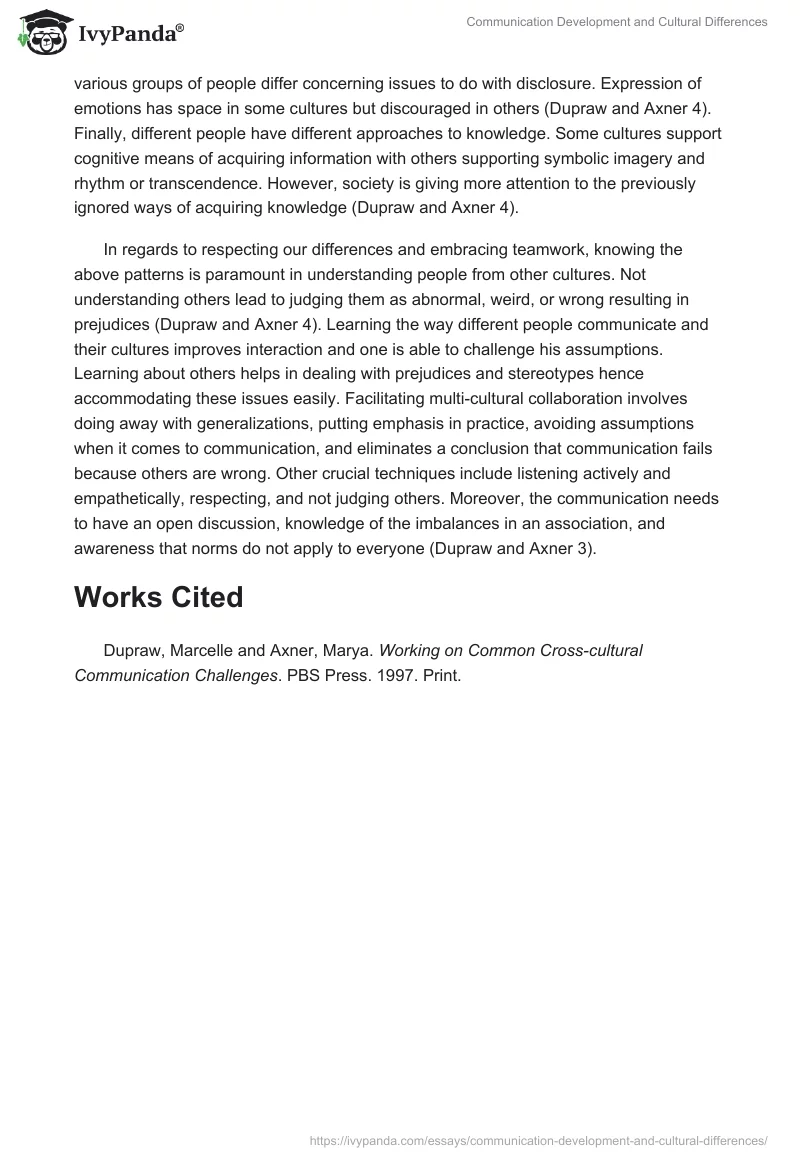The interaction between people of differing cultures is characterized by a fear of judgment and ineffective communication. Prejudice on people of different cultures leads to emotional and psychological hurting effects (Dupraw and Axner 1). When people are communicating, they have hopes of engaging in a conversation, learning from others, creating friendships, and viewing things from varying points of view (Dupraw and Axner 1).
Communication development and cultural differences become a barrier to information sharing in meetings (Dupraw and Axner 1). Culture can be viewed from a broad perspective to a point that people view themselves as belonging to different cultures. This article also argues that individual histories are determined by cultural influence. An individual is influenced by many factors and culture is one of the most powerful of them. Culture is a lens that one uses to view the world, a logic that gives the order to the world, and the grammar that enables a person to make sense of the world (Dupraw and Axner 2).
People view the world because of these issues, hence making sense and expression of it. Individuals from different cultures can be willing to work together, but it is common to have values of the various conflicting groups (Dupraw and Axner 12). Six crucial patterns of cultural differences explain how communication difficulties develop. First, there are different communication styles in different cultures. Language may be different with differing phrases and words having a differing application. Moreover, the criticality of non-verbal communication varies across cultures. The second pattern involves various attitudes attached to the conflict with some cultures viewing it as a positive issue while others avoid it (Dupraw and Axner 3).
The third pattern is the varying approaches to working on tasks whereby cultures have different ways of assigning people to complete tasks. Additionally, individuals from different groups have different views regarding collaboration and how work should be done (Dupraw and Axner 3). The fourth pattern has to do with the varying decision-making styles whereby the roles of making a decision vary across cultures. Moreover, various groups of people differ concerning issues to do with disclosure. Expression of emotions has space in some cultures but discouraged in others (Dupraw and Axner 4). Finally, different people have different approaches to knowledge. Some cultures support cognitive means of acquiring information with others supporting symbolic imagery and rhythm or transcendence. However, society is giving more attention to the previously ignored ways of acquiring knowledge (Dupraw and Axner 4).
In regards to respecting our differences and embracing teamwork, knowing the above patterns is paramount in understanding people from other cultures. Not understanding others lead to judging them as abnormal, weird, or wrong resulting in prejudices (Dupraw and Axner 4). Learning the way different people communicate and their cultures improves interaction and one is able to challenge his assumptions. Learning about others helps in dealing with prejudices and stereotypes hence accommodating these issues easily. Facilitating multi-cultural collaboration involves doing away with generalizations, putting emphasis in practice, avoiding assumptions when it comes to communication, and eliminates a conclusion that communication fails because others are wrong. Other crucial techniques include listening actively and empathetically, respecting, and not judging others. Moreover, the communication needs to have an open discussion, knowledge of the imbalances in an association, and awareness that norms do not apply to everyone (Dupraw and Axner 3).
Works Cited
Dupraw, Marcelle and Axner, Marya. Working on Common Cross-cultural Communication Challenges. PBS Press. 1997. Print.


